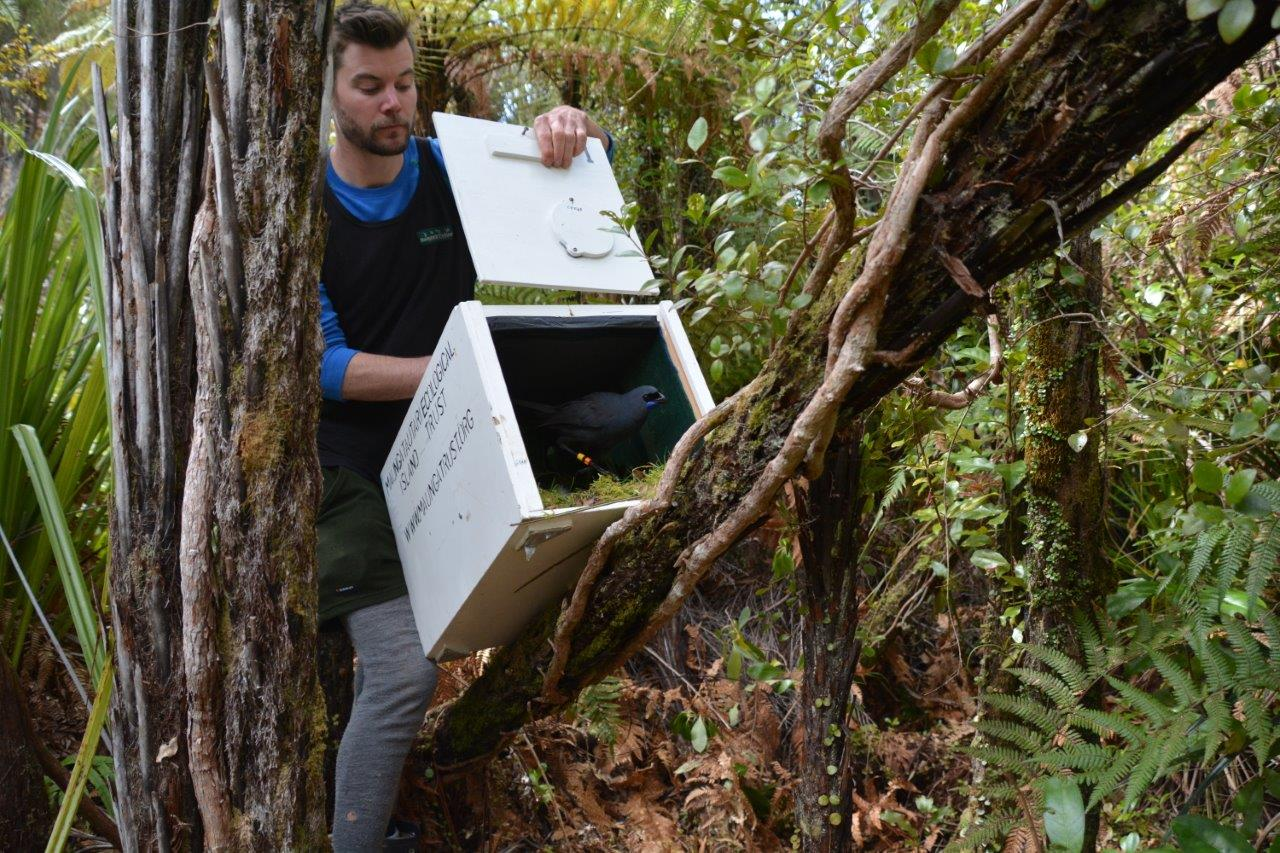Biodiversity Monitoring & Reintroductions
Photo by Amanda Rogers
Ark in the Park has an extensive monitoring programme to better understand wildlife such as kōkako, long-tailed bats/pekapeka and toutouwai/North Island robins. This tells us which species are present, how they are faring, and what we can do to help them thrive.
Sadly, some species that were once present at the Ark are now gone — having been driven to local extinction by pressures such as predation, habitat degradation or fragmentation. In some cases, we reintroduce or translocate species back to Ark in the Park.
As we rebuild the forest’s health and establish wildlife corridors, some species may return on their own. Already, kākā visit in winter and korimako/bellbirds may find their way.

Photo by Amanda Rogers
Reintroductions and translocations
We have reintroduced and translocated several bird species to Ark in the Park — either to boost existing populations or to bring back a species that was once present.
Though they don’t happen frequently, these reintroductions are a great opportunity for volunteers, who join trips to catch birds at different sites around New Zealand, help with their release, and monitor whether the birds have successfully established at the Ark or not. These findings are shared with other conservation groups across Aotearoa, to ensure that collectively we are able to provide the best care for our precious native species.

North Island Robin Toutouwai

North Island Kōkako

Whitehead
Pōpokatea
North Island robin/toutouwai
The return of toutouwai is one of the Ark’s greatest ecological success stories.
53 birds were relocated from Mokoia Island in Lake Rotorua in 2005. Another 30 were transferred to the Ark from Rangitoto Station near Otorohanga in 2009.
By 2015, the technical advisory group found the population had reached a secure size with enough genetic diversity to make this a successful introduction!
These birds were kindly entrusted to us by the Mokoia Island Trust and Ngāti Rereahu, who are the tangata whenua and iwi of these places.
Kōkako
Kōkako are renowned for their beautiful song and elusive nature. They disappeared from the Waitākere Ranges sometime between 1930 and 1960 and were returned to the forest by the Ark project in 2009.
To date, a total of 47 kōkako have been released at Ark in the Park. Two birds were gifted to the Ark by Tiritiri Matangi, with thanks to Ngāti Manuhiri and the Supporters of Tiritiri Matangi. The remaining 45 birds came from various sites around Maniapoto/King Country, with thanks to Ngāti Rereahu.
Our work with kōkako aims to increase the population within the Waitākere Ranges, while maintaining enough genetic diversity to meet targets established by the Kōkako Specialist Group.
Our monitoring of kōkako is intensive and includes two programmes per year; a census which is supported by Auckland Zoo, followed by nest monitoring. You can learn more about the results on our research page.
Census
Just like a human census we count how many kōkako are present within the Ark or spilling over into nearby forest areas. This is undertaken from late winter to spring.
A team of expert contractors leads this work, with specially trained volunteers working alongside them.
Both banded and unbanded birds are counted and pairings and territories are recorded for follow up later in the breeding season. Birds have coloured bands placed on their legs with unique colour combinations and numbers that allow individual birds to be identified. This is done when they are chicks, or prior to being translocated from their source sites. Locals can report kōkako sightings by getting in touch with the Ark team, which will help to inform where the census team will conduct their survey.
Nest searching
The information gathered from our kōkako census feeds directly into the nest searching programme. Again, contractors and specially trained volunteers check known territories for evidence that breeding pairs are nesting.
As they find nests, extra predator control is set up and the team begins monitoring the behaviour of the birds. Usually, 2 or 3 eggs are laid, which hatch after about 18 days. Both parents bring food of insects, leaves and berries to the chicks and the timing of these visits helps determine when the time is right for qualified people to band the chicks.
Other translocations
Attempts were also made to reintroduce hihi/stitchbird and pōpokatea/whitehead, however these species did not establish. The learnings from these translocations are used to better understand their ecology, and to inform future translocations across Aotearoa.
- Whitehead/pōpokatea monitoring results 2019/20 (PDF, 632 KB)
- Whitehead/pōpokatea translocation report 2016 (PDF, 576 KB)
- Hihi/stitchbird monitoring results 2008 (PDF, 94 KB)

Photo by Jason Hosking
Other species monitoring
Long-tailed bat/pekapeka-tou-roa
We will be starting a long-tailed bat monitoring project in the near future to understand where they feed, forage and roost so we can better protect them.
Predator monitoring
Volunteers check how effective our predator control efforts are by monitoring rats several times a year.
This involves putting tracking tunnels with inked paper or cards in the bush for one night. The following day, they are collected and volunteers count how many have footprints and how many do not. This gives us a percentage as a gauge of rat numbers that we can compare with other areas of the Ark, as well as other seasons or years, and even other places in Aotearoa/New Zealand.
